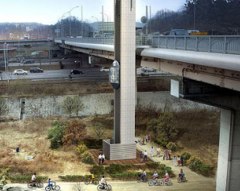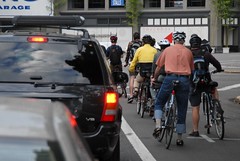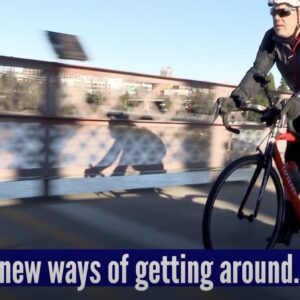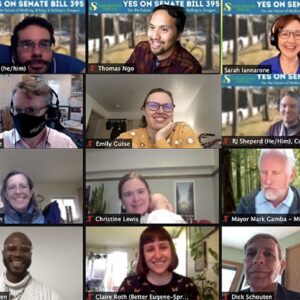
one way Seoul, South Korea hopes
to reach 10% bike mode share by 2020.
(Graphic: Chosun Ilbo)
Seoul, South Korea, a city with just 1.6% of their population regularly using bikes (Portland is at 6% by comparison) has set an aggressive plan to bump that up to 10% by 2020.
They’ve launched several initiatives to reach that goal (like parking and shower facilities at subway stations, bike elevators to get to bridges, and more), but one of them in particular caught my eye because it’s something I’ve been thinking about a lot myself – re-allocating existing roadway space to bike traffic.
According to an article in the Chosun Ilbo, the Seoul city government office of urban traffic will use the “road diet” principle to create bicycle-only lanes on 207 km of roads by narrowing existing motor vehicle lanes.
Another source for the story (thanks for the link Jessica), which is ironically a site about driving cars, puts it this way:
The….plan is based on a “road-diet” programme, under which the number of lanes for passenger vehicles on major roads will be cut to create new cycle paths.
That story also quotes the Mayor of Seoul as saying:
“We will make sure that bicycles will compete with vehicles for commuting in Seoul,” said Mayor Oh, who rides his bicycle to work every day.
And my favorite part of that story — “He did not outline any plan to consult motorists.”
What also makes this news interesting to me is that Seoul is doing this for two reasons you don’t often hear about in the States: to save money and to proactively encourage biking.
In the U.S., politicians and planners seem content to wait until either their hand is forced by community outcry (usually sparked by a serious injury or fatal collision like we saw here in Portland last October) or for bike traffic to reach a breaking point (are we getting close yet?).
In Seoul, they’ve only got about one-third the bike usage rates of Portland, but they’re being proactive in their policies and truly living up to the “if you build it, they will come” mantra.
Seoul is selling their plan to the people by touting that the resulting increase in bike use will save them $547 billion Won (that’s $387 million U.S.) because of reduced pollution alone.
This is inspiring leadership. Portland needs a plan like this, but I realize our political and cultural context is vastly different (in Seoul they replaced a downtown freeway with a river!).
As Seoul’s plan reminds us, we’ve already got the infrastructure we need. There are plenty of multi-lane roads here in Portland that can be re-configured to more safely accomodate bike traffic. There are also many roads that could become safer for bikes if on-street motor vehicle parking was removed.
Back in August, in a report on an event celebrating our Platinum achievement, I wondered if Portland was ready for a “10% by 2010” campaign.
I think we can do it, but it’ll take a bold plan (no such campaign exists in Portland) and proactive leadership to get there.






Two words: bike elevator!!
“road diet.” I really like the sound of that.
From the Guardian article on removing the freeway and replacing the river: “‘Braess paradox’, which says that by taking away space in an urban area you can actually increase the flow of traffic, and, by implication, by adding extra capacity to a road network you can reduce overall performance.”
I saw this in action in Tucson, where I lived 18 years. A number of dangerous, narrow and congested 4 lane city streets were reduced to two lanes, with bike lanes, and sometimes dedicated left turn lanes. As a driver I was amazed. Traffic flow was slightly slower but much more constant, and the driving experience on those street was much more relaxing and enjoyable.
I was really bummed they didn’t do this on the St. John’s bridge, because the rush hour congestion there has nothing to do with the traffic capacity of the bridge, but of St. John’s itself.
It took them long enough to get there. Every time I’ve been to Seoul, it’s just been one big traffic jam. At times, it’s faster to walk. As is usual, the folks there blame everyone else for being on the road, and getting in the way.
Mind you, riding a bike in all that pollution isn’t going to be fun, although driving in it isn’t either.
Are you sure about the $1.1 million. That does not seem like much. Not even a 1/3 of a bike bridge over 405.
547,000,000,000.00 KRW = 387,619,793.196 USD
Bike elevator? Got one of those (well, it’s for cars too… .) in Oregon city. Just joking.
The Guardian story about the restored river in Seoul was very interesting. Amazing that the city could do that for the money they spent: $380 mil to recreate a river; “….create a five-mile long, 800-yard wide, 1,000-acre lateral park snaking through the city where the river once ran.”
Around the time light rail was installed in Goose Hollow, Portland planners gave thought to restoring the stream or creek that once ran through there. Guess it was too expensive or too complicated to do.
The Guardian story is interesting also for the disruption it tells that the city’s residents residents and businesses were subject to as a result of the river restoration. Relations between people on big projects like that are going to be a major challenge to manage.
“Are you sure about the $1.1 million.”
oops my mistake.. i did the conversion too but for some reason typed the $1.1 million figure… i’ve corrected the post.
thanks.
I have had this thought about roads and bikes: Why not take neighborhoods with parallel running streets and make those street alternating one way, making room for a large bike lane. In a neighborhood with crisscrossing blocks, you would only have to go at the most 2 blocks to be able to go in the direction you want. A smal price for liveable streets.
In Eugene they use a three street combination. One way opposing directions on (I think) 10th and 12th with 11th as a bike boulevard with lots of forced turns for autos but not bikes. There are other places in Eugene where they do that too.
Jonathon you mention the unusual reason for Seoul’s program: “to save money and to proactively encourage biking.” Neither of these positions are supportable in our current two party system.
Democrats have a long history of public spending to stimulate the economy, and roads are an easy sell, cost lots of money providing a lot of stimulus, and they give the illusion of providing a benefit to all of society regardless of class. As far as proactively advocating cycling, well that will have to come from within the party leadership, and they have been trying to look like Republicans since elected Reagan. Many environmentally and ethically minded Democrats are very careful not to appear too green or too socially conscious to avoid being labeled anything but mainstream.
While “The Party that Wrecked America” gives lip service to smaller cheaper government, the party is ruled by corporate lobbyists that will block any movement that tends to limit industrialization, relax social control, or reduce energy inputs into society. As a result, encouraging bicycling will be a tough sell when it comes to GOP faithful, regardless of the economic sense it makes. Besides, the breeze from a bike would play hell with McCain’s comb-over.
Even Libertarians have been blinded by the goodness of cars and roads so we have the freedom to kill and maim ourselves without government interference.
The loss of critical thinking and degradation of media integrity has made original ideas a very tough proposition for any public leader to support. It is nice to see somewhere in the world that is not divided into left and right.
“There are plenty of multi-lane roads here in Portland that can be re-configured to more safely accomodate bike traffic. There are also many roads that could become safer for bikes if on-street motor vehicle parking was removed.”
Hmm, maybe this should start another topic: which multilane roads should be top priority for such conversion? Which streets should have on-street parking replaced with separated bike lanes? After discussion here at BikePortland, why don’t we or the BTA or whoever come up with a plan to suggest to the city, then make every political candidate take a position on whether they support it?
I agree with you Brettoo…
i’ve been thinking about that topic a lot and can definitely do a story on it.
and I also agree that it might spark an opportunity for activism that the community might get behind. stay tuned.
Why does this blog continue to assert that 6 percent of all commutes in the City of Portland are by bike? It’s a bogus, inflated number, based soley on a City of Portland auditor’s survey, and at odds with 1)census statistics (which I recall were cited on this blog some weeks ago, and which put the numbner at approximately 4.2 percent; 2) Bike Commute Challenge numbers (which tell us that when the weather is still good and everyone is being actively encouraged to ride for one month, the number is maybe approaching 5 percent); and 3) common sense – the claim that 6 percent of commutes (on average, year round) are by bike just doesn’t hold up as an as an observable fact. Continuing to make that claim, I think, is at some point going to raise a credibility issue.
“hy does this blog continue to assert that 6 percent of all commutes in the City of Portland are by bike? It’s a bogus, inflated number,….”
I disagree Kurt.
The census number is no more credible a measure of bike share than the auditor’s number. In fact, the real issue is that we don’t really have a solid grasp of the real number… however I think 6% is a very reasonable number to report.
The census, ACS, and Auditor’s surveys all just ask about primary commute mode. We know that 80% of all trips are NOT commute trips, and furthermore that commute trips are the longest and least flexible trip (read: hardest to do by bicycle).
In light of this, I’d say that ALL existing measures of bicycle modeshare in Portland seriously underestimate current use. If we could include the trips to the library, the market, to visit a friend, to access the nearest path, I think we’d see far more than 6%.
Oh, and I recently learned that the Auditor’s Office adjusts their responses to represent neighborhood demographics. So you’re hearing from a representative sample of the neighborhood. To me, that adds credibility to the results.
At the risk of getting in trouble again, I think this story highlights what it is that makes me so distrustful of CRC Sam. He has never once argued that increased bike infrastructure will create increased bike modeshare, or certainly not when it matters. He’s a follower, not a leader.
“If we could include the trips to the library, the market, to visit a friend, to access the nearest path, I think we’d see far more than 6%.”
Not sure this conclusion follows – assuming all the people that drive a car to commute, also drive to go the library, the market, to visit a friend, etc, I don’t see how the fact that people that ride their bikes to commute also ride to do all those things increases the 6% number – seems they would balance out – no? In any case, the claim is 6 percent commute trips – that is the standard measure and that is what the city is claiming, if that number is overstated, then it is overstated, regardless of how may people ride their bike to the library (even if those same people drive a car to work).
“The census number is no more credible a measure of bike share than the auditor’s number”
Then why default to the higher number? Wouldn’t the census number be more reliable (all houses) if the auditor’s number is based on a survey (a sampling of houses)? Have you looked at the BCC numbers? Do they support a 6% year round claim, let alone a 6% September Bike To Work Month claim? What about the city’s annual volunteer bike count numbers? I’ve participated in few, I just can’t get to 6%. Wish I could.
“The Auditor’s Office adjusts their responses to represent neighborhood demographics. So you’re hearing from a representative sample of the neighborhood”
What does this mean? What demographics and what adjustments?
I live in Seoul and have been doing a bunch of biking since I bought a bike here. What scares most people is the traffic. If there were “safe” places to bike here I think people would be all over it. As it currently is the bike paths along the Han River are packed on the weekends.
I still only see a handful of actual commuters though.